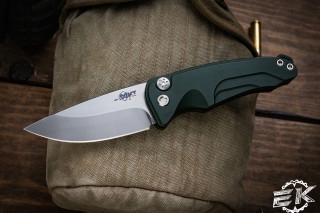The Auto Knife: Options for Self-Defense
Posted by Clayton on Nov 2nd 2021
The Industrial Revolution and development of spring steels paved the way for the automatic knife, first designed and produced by George Schrade. A toolmaker and machinist from New York, he patented the first of several practical automatic knife designs and began manufacturing in 1893. These proved to be popular throughout the years, bolstered by the growing mail-order catalog industry. Imagine the excitement when customers were first able to purchase a quality auto knife from Sears and Roebuck through the mail!

Who needs an automatic knife?
Women were early adapters of the automatic knives available in its first iterations. They presented significant advantages over fixed blade or manually operated folding knives — mainly that they could be kept out of sight until needed and concealed in a smaller area than a fixed blade. The retracted blade presented less of a hazard, protecting the owner from the danger of a self-inflicted injury. Also, the auto knife was easier to deploy under stress than a manual blade because an adrenaline dump diminishes fine motor coordination to the point that detailed tasks become impossible. Smashing a release button with the thumb is far easier than attempting to pinch a slender piece of blade and pry it open while someone is trying to use your head like a piñata.
Using a knife for defense is fairly straightforward. It is a contact weapon, and even the most inexperienced user can manage to plant it where it will do some damage. As one DEA agent once said of the knife, “They never jam, and they never run out of ammo.”
Aren’t ‘switchblades’ illegal?
These advantages of the early auto knives apply equally today for both men and women. Self-defense auto knives like the Microtech UTX-85 are easy to carry concealed, and in many jurisdictions are an easier option than carrying a firearm. In the United States, there are multiple layers of regulations that auto knife customers need to be aware of. Each state regulates ‘switchblades’ or auto knives differently, and there are multiple federal statutes that regulate the sale, manufacture, import and interstate transportation of these products. Auto knife customers need to be aware of the patchwork of national laws when travelling with their preferred blade.
US Knife Laws by State
As of mid-2018, 18 states have little to no restrictions on auto knives.
ON the other hand, 21 states have some sort of restriction on auto knives, which can vary from a near-total ban to simply requiring a weapon permit to carry. They require careful review as there are a multitude of exemptions and restrictions for each jurisdiction.
Ten states or territories completely prohibit automatic knives and are a no-go for legal carry.
How big should a knife be?
Some legal restrictions focus on blade length and shape. Many states specify length limits, ranging from 1.5 inches to 3 inches maximum. Others focus on double-edged blades or call out ‘stiletto’ or ‘dagger’-type blades that have no cutting edge but are intended for straight thrusting.
For a defensive knife, like a Benchmade OTF Infidel, a longer blade is typically better than a shorter one. For straight-thrust attacks, blade length limits how far you can penetrate to stop an assailant. For slashing attacks, the longer blade can cut deeper to reach tendons and cut muscle, which will eliminate an assailant’s mobility. Most defensive knives fall into the 2.5- to 4.0-inch range, which strike a balance between practicality and effectiveness.
Knives with folding or retracting blades are limited in size by the length of the blade, with undeployed blade length representing one-half of the deployed blade length of the knife. This means that a 2.5-inch blade knife will have about 3-inches of handle to hold onto, so the longer blade length gives you more to grip. This translates into the amount of leverage or force you can direct into the target and how well you can maintain control of the knife.
Aren’t they all the same?
There are a few types of automatic knife design available: out-the-front or OTF knives, single action, OTF double action and side-opening.
The single action OTF propels the blade out the front of the handle in a straight line and locks it in place. The operator must manually release the locking mechanism and retract the blade.
The double action OTF type deploys the blade in the same manner but will also automatically retract the blade by pressing the activation button a second time. These typically have a weaker deployment spring than the single action type.
The side opener type swings the blade out from the side of the handle just like a regular pocketknife and is manually retracted into the handle once the lock is disabled. A good example of an automatic side opener is the Microtech Stitch.
An automatic knife like the ProTech Emerson CQC-7A is a viable option for self-defense. It can put a smaller defender on an equal footing with a larger attacker and doesn’t require the same level of training that a firearm would. It’s advantages over traditional folders make it a worthwhile investment in those areas where they are legal to use.

